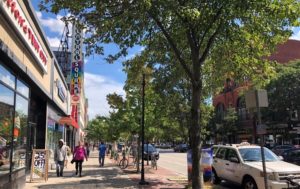1905: A Year of New Beginnings
By Michael Kenney, 2015
Call 1905 “a year of new beginnings.” It marked not only the final decision on a new subway route—today’s Red Line—but also the birth of the Cambridge Historical Society. Well into the year, there was debate over whether to run a subway underground once it crossed the Charles River, or to run an elevated line through Central Square, going underground at Bay Street. That option was favored by the Square’s business community and by none other than Harvard President Charles William Eliot. “Transportation in a tunnel,” Eliot opined, “is the most disagreeable mode now anywhere used.” But in mid-April, a “who’s who [of ] leading citizens,” as the Cambridge Chronicle put it, tipped the scales for a fully underground route.
For springtime diversion, the Chronicle reported in May, there was the “horse-and-buggy” yarn, about “a finely appearing young lady” who had been hiring a horse and buggy from a Richdale Avenue stable, “paying with worthless checks,” and claiming to be the daughter of wealthy parents “with a summer place on the Maine coast.”
On June 15, the Cambridge Historical Society was formed, under the leadership of Richard Henry Dana III. A Harvard alumnus, Dana was an attorney and civil service reformer. “Many in Cambridge,” reported the Chronicle, “have long looked for such a society.”
“Never Too Late to Talk Politics,” ran the Chronicle’s headline in mid-July. “It helps to keep citizens warm in November and December.” There were rumors of prospective candidacies for mayor among both the Democrats and the Non-Partisan forces—a forerunner of the contests a half-century later between the old-line forces and the Cambridge Citizens Association. It all shook out in November with Democrat Charles H. Thurston facing off against Citizens Party candidate Warren X. Blodgett, with Thurston winning in an 88-vote squeaker.
September saw the death of Frederick Hastings Rindge, donor of city hall, the library, and the manual arts school, which became the “Rindge” in Cambridge Rindge & Latin School. Raised in the “Rindge mansion,” still standing at the corner of Dana and Harvard streets, and later known as “Cambridge’s greatest benefactor,” Rindge moved to California in 1887, but was lobbied by Mayor William Eustis Russell, a Harvard classmate, to fund the projects.
Later in the year, John H. Corcoran—the city’s “most progressive and successful merchant,” as the Chronicle put it—bought Hyde’s Block, a prominent 19th-century building in Central Square. It became Corcoran’s department store and operated until 1950, when it was taken down. Meanwhile, long-time city engineer Lewis Hastings, who had been ousted by the Democrats, was reinstated by the incoming Non-Partisan aldermen. Hastings’s history of the city’s streets was published in the historical society’s Proceedings. And then, at year’s end, the historical society sponsored the celebration of the city’s 275th anniversary at Harvard’s Sanders Theater. “Its duty,” said society president Richard Henry Dana, should be not just “the mere marking of this or that historic spot,” but to go “deeper into history and interpret the life and spirit of our illustrious ancestors.”



